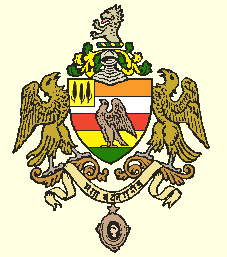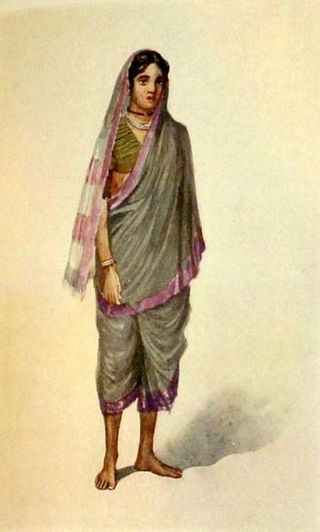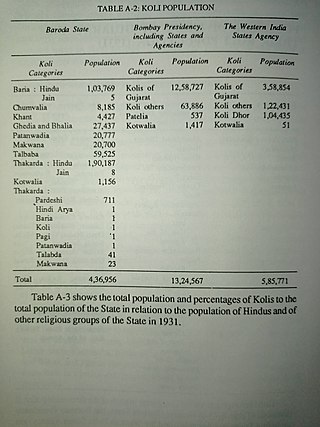
The Soni are a Hindu caste of goldsmiths found throughout India in the states of Rajasthan, Gujarat, Madhya Pradesh. [1] The Soni caste of Gujarat, don't take food touched by Rajputs because Rajputs are inferior to the Soni caste. [2]

The Soni are a Hindu caste of goldsmiths found throughout India in the states of Rajasthan, Gujarat, Madhya Pradesh. [1] The Soni caste of Gujarat, don't take food touched by Rajputs because Rajputs are inferior to the Soni caste. [2]
The Soni are essentially still goldsmiths, with a few also involved in the manufacture of other items of jewellery. [3] Like similar Hindu castes, they are endogamous and maintain a system of clan (gotra) exogamy. The various sub-divisions of the Soni have their own caste associations, such as the Patni Soni Mandal and Shrimali Soni Mandal. They follow Vaishnavism, and many belonging to the Swaminarayan sect.
Rajput, also called Thakur, is a large multi-component cluster of castes, kin bodies, and local groups, sharing social status and ideology of genealogical descent originating from the Indian subcontinent. The term Rajput covers various patrilineal clans historically associated with warriorhood: several clans claim Rajput status, although not all claims are universally accepted. According to modern scholars, almost all Rajput clans originated from peasant or pastoral communities.

Khatri is a caste originating from the Malwa and Majha areas of Punjab region of South Asia that is predominantly found in India, but also in Pakistan and Afghanistan. The Khatris claim they are warriors who took to trade. In the Indian subcontinent, they were mostly engaged in mercantile professions such as banking and trade. They were the dominant commercial and financial administration class of late-medieval India. Some in Punjab often belonged to hereditary agriculturalist land-holding lineages, while others were engaged in artisanal occupations such as silk production and weaving.
Patel is an Indian surname or title, predominantly found in the state of Gujarat, representing the community of land-owning farmers and later businessmen, agriculturalists and merchants. Traditionally the title is a status name referring to the village chieftains during medieval times, and was later retained as successive generations stemmed out into communities of landowners. There are roughly 500,000 Patels outside India, including about 150,000 in the United Kingdom and about 150,000 in the United States. Nearly 1 in 10 people of Indian origin in the US is a Patel.

The Khalji or Khilji dynasty was the second dynasty which ruled the Delhi sultanate, covering large parts of the Indian subcontinent for nearly three decades between 1290 and 1320. It was founded by Jalal ud din Firuz Khalji.
Parmar, also known as Panwar or Pawar, is a Rajput clan found in Northern and Central India, especially in Rajasthan, Gujarat, Punjab, Haryana, Uttarakhand, Uttar Pradesh, Bihar, Madhya Pradesh and North Maharashtra. The clan name is also used by Kōḷīs, Garoḍās, Līmaciyā Valands, Mōcīs, Tūrīs, Luhārs, Kansārās, Darajīs, Bhāvasārs, Cūnvāḷiyās, Ghañcīs, Harijans, Sōnīs, Sutārs, Dhobīs, Khavāsas, Rabārīs, Āhīrs, Sandhīs, Pīñjārās, Vāñjhās, Dhūḷadhōyās, Rāvaḷs, Vāgharīs, Bhīls, Āñjaṇās, Mer and Ḍhēḍhs.

The Rathore or Rathor is an Indian Rajput dynasty belonging to the clan that has historically ruled over parts of Rajasthan, Gujarat and Madhya Pradesh.

Mahar is a caste found largely in the state of Maharashtra and neighbouring areas. Previously they along with many other Hindu castes were treated as untouchables. The injustice of this practice was the primary reason for most of the Mahar community to follow B. R. Ambedkar in embracing Buddhism in the middle of the 20th century. There are still some Mahars who practice Hinduism.
Muslim Rajputs or Musalman Rajpoots are the descendants of Rajputs in the northern regions of the Indian subcontinent who generally are followers of Islam. Reportedly, they converted from Hinduism to Islam from the medieval period onwards, creating various dynasties and states while retaining Hindu surnames such as Chauhan. Today, Muslim Rajputs can be found mostly in present-day Northern India and Pakistan. They are further divided into different clans.

Jadeja is a Rajput clan that inhabits the Indian state of Gujarat and the Tharparkar district of Sindh, Pakistan. They originated from Sammas of Sindh, a pastoral group, and laid a claim on the Rajput identity after marriages with Sodha Rajput women by adopting a process called Rajputisation.
Garasia, alternatively spelled Girasia, Girasiya or Garasiya, is a title used by the Koli chieftains of petty states or Jagirdars in India who held the villages as Giras granted by rulers. Many of the Chunvalia Kolis held the title of Girasia and they worshipped the Hindu goddess Shakti.

Lohar is considered to be a caste among Hindus and a clan among Muslims and Sikhs in the Indian states of Uttar Pradesh and Jharkhand, and in Nepal. They form traditionally artisanal castes. Writers of the Raj period often used the term Lohar as a synonym for blacksmith, although there are other traditional smiting communities, such as the Ramgarhia and Sikligar, and numerous non-traditional communities, including the Kayastha, Rajput and Brahmin.
Bhumihar, also locally called Bhuinhar and Babhan, is a Hindu caste mainly found in Bihar, the Purvanchal region of Uttar Pradesh, Jharkhand, the Bundelkhand region of Madhya Pradesh, and Nepal.
The Swarnkar is a Kshatriya caste in India. Swarnkar is a hindu suryavanshi and chandravanshi caste in India. The Sonar community works trader of gold or as goldsmiths. The community is primarily Hindu, and found all over India.
The Vala, or Wala is a Gujarati clan (Gotra) mostly found among Koli, Rajput and Kathi castes of Gujarat.

Baria, or Baraiya,Bareeya and Bariya is a clan (Gotra) of the Koli caste found in the Indian State of Gujarat and Dadra and Nagar Haveli and Daman and Diu. the Devgad Baria was their Stronghold or given their name to Baria State in Gujarat. according to the historian Y.V.S Nath, the ruling royal family of Baria State is original Koli by caste but later they claimed to be of Rajput origin to be in high status among other Princely States.

The Koli is an Indian caste found in Rajasthan, Himachal Pradesh, Gujarat, Maharashtra, Uttar Pradesh, Haryana, Karnataka, Odisha and Jammu and Kashmir states in India. Koli is an agriculturist caste of Gujarat but in coastal areas they also work as fishermen along with agriculture. In the beginning of 20th century, the Koli caste was recognised as a denotified tribe under Criminal Tribes Act by the Indian Government because of their anti-social activities during World War I.
KHAM stands for Koli Kshatriya, Harijan, Adivasi and Muslim. Here Kshatriya is taken to include the Kolis. In the KHAM combine, Kolis were the largest caste represented at different levels of politics, and Madhavsinh Solanki increased the reservation quota for Other Backward Classes in Gujarat. The theory was propounded by Madhavsinh Solanki in 1980s in Gujarat to create vote bank for Indian National Congress and prepared by Jhinabhai Darji. Using the formula, Congress was able to capture 149 seats in the 182-member Assembly. However the formula alienated Patels permanently from Congress. during the Kham alliance, castes such as Bania, Patidar and Brahmins lost their importance in the state, so they propounded the Anti reservation agitation in 1981 and 1985 in Gujarat to get rid of the power of OBC castes.
The Jat people are a traditionally agricultural community in Northern India and Pakistan. Originally pastoralists in the lower Indus river-valley of Sindh, many Jats migrated north into the Punjab region in late medieval times, and subsequently into the Delhi Territory, northeastern Rajputana, and the western Gangetic Plain in the 17th and 18th centuries. Of Hindu, Muslim and Sikh faiths, they are now found mostly in the Indian states of Punjab, Haryana, Uttar Pradesh and Rajasthan and the Pakistani provinces of Sindh and Punjab.
The Muslim Koli, or Musalman Koli is a religious subgroup of Hindu Koli caste in India and Pakistan. Most of the Muslim Kolis lives in Maharashtra and Gujarat of India and Sindh province of Pakistan. Muslim Kolis were Hindu by religion but later they were converted to Muslim and accept Islam.
The Chauhan Koli is a clan (gotra) of the Koli caste living in the Gujarat and Rajasthan states in India.